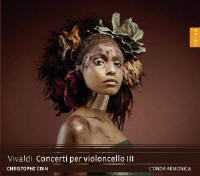Texte paru dans: / Appeared in: |
|
|
Reviewer: Michael
De Sapio Baroque cellist Christophe Coin takes a rhapsodic approach to Vivaldi, giving individual phrases a different expressive treatment, with rubato and portamento integrated tastefully into the musical line. His tone is impeccably sweet and vocal, his phrasing characterful and expressive. Vivaldi’s solo figuration is, let’s face it, not always intrinsically interesting, so Coin wisely takes the cue to dream and rhapsodize, which he does quite seductively. As with French Baroque music, with Vivaldi it’s not so much about the notes on the page as about the manner in which you turn a phrase. Coin, incidentally, plays on a c. 1720 Alessandro Gagliano cello for the majority of the program, and a 1757 five-string violoncello piccolo for the final concerto. Coin explains that he plays this latter instrument standing up, with the cello placed on a table. This is the first time I have encountered L’Onda armonica (The Harmonic Wave), one of a seemingly endless supply of Baroque groups in Europe. Their sound is light and flexible and sunny, but never wispy or insubstantial. While inventive dynamic schemes and creative articulation are used, nothing ever sounds contrived or forced or needlessly driven. Finales can take on an offhand, throw-away quality, and an easygoing ambiance prevails. Both Coin and the orchestra play immaculately in tune. The best compliment I can pay these performances is that they sound effortless—unlike some Vivaldi performances these days, about which the phrase “trying too hard” comes to mind. Bassoon, organ, and plucked instruments add color to the bass line and are used with exemplary good taste. An interesting short interview with Coin is included in the booklet, in which he discusses the little effects Vivaldi creates to offset the criticism of monotony in his music. This is, for those who are keeping track, Volume 61 of Naïve’s Vivaldi Edition.
| |
|
|
|
|
|
|
|
Cliquez l'un ou l'autre
bouton pour découvrir bien d'autres critiques de CD |
|




